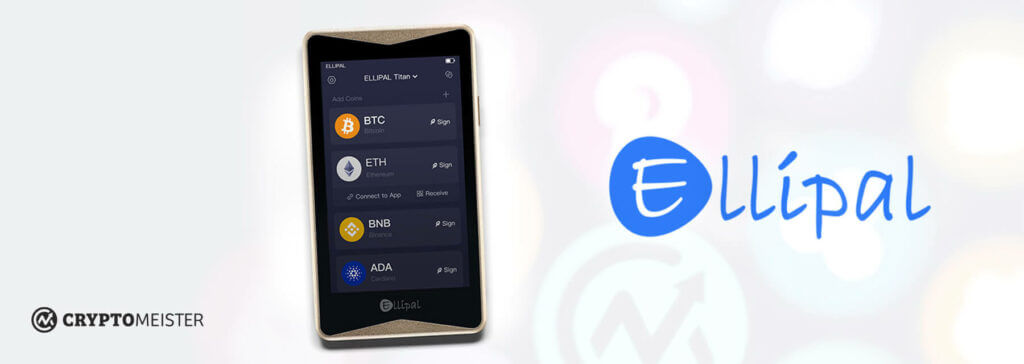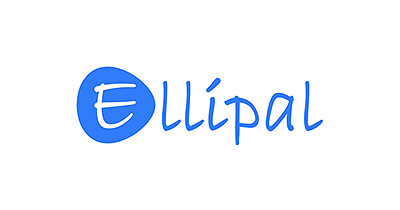Ellipal Wallet Review
If the second half of 2022 taught crypto users anything, it is that self-custody is the only reliable way to store your digital assets. The safest form of self-custody is a hardware wallet, and one of the more under the radar operators in this sector is Ellipal, despite it being around since 2016.
Ellipal was launched with the idea of creating what one of the founders, David Tian, in 2019 termed the “air-gapped cold wallet”. This philosophy has resulted in the creation of the Ellipal Titan range of hardware wallets, which Ellipal says is “the most secure cryptocurrency cold wallet” range on the market.
In this Ellipal review we look at what Ellipal hardware wallets are, how they work, and whether they really are the best option out there for digital asset holders.
What is a Ellipal hardware wallet?

A Ellipal hardware wallet is a device that allows you to store your digital assets, such as cryptocurrencies and NFTs, offline and ‘air-gapped’. Also referred to as a ‘cold’ wallet, this type of digital asset storage represents the best defense against hackers and is the method that provides both high levels of security and practicality.
An Ellipal cold wallet allows you to send, receive and store thousands of cryptocurrencies as well as NFTs from almost 50 blockchains in an extremely secure manner. The large color touchscreen of the Titan gives it the look of a rather old school cell phone, with the Titan Mini resembling a kind of modern pager (ask your dad). They may look a bit old school, but they are very much contemporary under the screen.
Talking of the screen, this is a feature that sets Ellipal apart from the competition. Of the mainstream crypto hardware wallets, only the Safepal S1 has attempted to implement a color screen. However, it is nothing compared to the full-sized, touchscreen effort that Ellipal hardware wallets have.
This feature will appeal to many who find the tiny screens and physical buttons found on the likes of Trezor and Ledger wallets off-putting or intimidating. Despite being first developed and launched in 2018, the design of the Ellipal Titan range ensures that it still ranks higher in the aesthetics stakes than its better known rivals.
How does a Ellipal wallet work?
An Ellipal cold wallet is designed to keep digital assets offline at all times, making it almost impossible for someone other than the wallet’s owner to move them. This is in contrast to digital assets held in wallets on phones or computers, or left on an exchange, which are referred to as ‘hot’ wallets.
These hot wallets are maintained by third-party companies, and if their servers ever get compromised then hackers can potentially get into your wallet and move your assets without you knowing. Alternatively, as we have seen in 2022, exchanges can go bankrupt and lose your funds, even the ones that seem the safest bets around.
The Ellipal cold wallet range is ‘air-gapped’, which is a technical term for a device (usually a computer) that does not have a connection to a network or another device. In other words it is 100% isolated from the outside world.
When it comes to your digital assets, this is incredibly important as it provides an impervious barrier for would-be hackers, who need the internet to do their dirty work.
A hardware wallet isn’t a wallet in the traditional sense, in that it doesn’t hold any funds. The funds are held in addresses on the blockchain, with the Ellipal mobile app being the portal through which assets are accessed and sent.
If you’re thinking “hold on, my phone is connected to the internet”, don’t worry – no funds can leave your wallet without the transactions being physically confirmed on your Ellipal hardware wallet first.
The Ellipal wallet doesn’t get involved when you are receiving funds, with the mobile app doing all the legwork, but the story is different when you want to send funds out. This requires creating the transaction on the mobile app, which generates a QR code. You then use the camera on the Ellipad to scan the QR code before tapping the screen to confirm the transaction.
When not being used to send coins, the Ellipal cold wallet can sit in a safe or other secure location, turned off to conserve power until it is needed.
Supported cryptocurrencies
Ellipal supports over 10,000 cryptocurrencies and NFTs from 48 blockchains, with the company saying that it adds new blockchains all the time. This is in stark contrast to, say, KeepKey, which hardly ever updates its supported coins list.
Ellipal provides a full list of supported coins here, but some of the most popular coins that Ellipal col wallets support are:
- Bitcoin (BTC)
- Ethereum (ETH)
- Polkadot (DOT)
- Ripple (XRP)
- Tether (USDT)
- Solana (SOL)
- Binance Coin (BNB)
- Algorand (ALGO)
- Chainlink (LINK)
- Shiba Inu (SHIB)
- Cardano (ADA)
- Avalanche (AVAX)
The Ellipal cold wallet range also supports NFTs on all supported blockchains, with the mobile app displaying them in a nice gallery when you want to view your collection.
Ellipal wallets – the lowdown
Price
The Ellipal Titan, launched in 2018, had a retail price of $169 since its launch all the way to mid-2022, putting it at the premium end of the scale at the time. However, with the launch of the Titan Mini, this price was dropped to $139. This is still around half the price of the Trezor Model T and is just $20 more expensive than Ledger’s flagship, the Nano X.
The Titan Mini retails for $79, the same price as the Ledger Nano S Plus, and twice that of the SafePal S1, having launched initially at $99.99 in 2019. This price drop is almost certainly in response to the Ledger Nano S, its direct competitor, launching at $79 in 2022.
Security
Ellipal prides itself on the security of its devices, and rightly so. The simple fact is that it is impossible to connect an Ellipal Titan wallet to the internet in any way, which is what puts it at the top of the tree when it comes to security.
Other devices, such as Trezor and Ledger wallets, need to be connected to a computer in some way to carry out certain transactions, which presents a security threat. This isn’t the case with the Ellipal – even firmware updates are carried out via SD card.
On top of this there’s the fact that the wallets themselves are almost indestructible – the team have even run a car over one to prove this!
Setup
Setting up an Ellipal Titan wallet is very easy, with instructions in the box and plenty of videos online to guide you. Everything is done through the Ellipal app (make sure you download the app using the QR code printed on the box so you know it’s official), with the only onerous part being the recording of your mnemonic recovery code.
This is vital however, as it is the code that will allow you to recover access to the funds in your wallet should you ever need to reset it, or if you lose it somehow. Beware however, because if someone else gets hold of this mnemonic phrase then they too can access your funds.
Once you’ve set up the wallet (and installed the firmware via an SD card, not included), it’s time to receive some assets. This involves simply setting up the blockchain wallet in the mobile app, revealing the address and sending the funds over.
You can also try out one of the 200+ dApps supported by the Ellipal Titan wallet range, allowing you to swap, lend/borrow, and stake coins, as well as adding NFT functionality. Again, all this is done through the mobile app, with the hardware wallet itself only getting involved when you want to send some coins or an NFT somewhere.
Competition
Considering what you get for your money, the Ellipal Titan is much better value than Trezor’s premium offering, the Model T, and is probably also better value than the Ledger Nano X, especially for those who want that bit of extra security and prefer a device that looks like a cell phone.
The Titan Mini fulfills the same role as the Ledger Nano S Plus – it has the core features of its older brother, but it comes in a smaller form factor. The Titan Mini retails for the same price as the Ledger Nano S Plus, and twice that of the SafePal S1.
It’s clear that the Ledger Nano S Plus and the Titan Mini sit in the premium economy category, and the Titan Mini pips the Ledger Nano S Plus when it comes to security, although the Ledger Nano S plus has the edge when it comes to functionality, given that you can use it directly with dApps such as MetaMask.
Ellipal Titan vs Titan Mini
As we’ve mentioned, Ellipal makes two hardware wallets – the Ellipal Titan and the Ellipal Titan Mini. The Ellipal Titan was launched in 2018, the same year as Trezor’s Model T, and still very much stands up compared to others that have not evolved with the space.
The Ellipal Titan Mini, launched in 2019, has all the features of the Ellipal Titan but in a package almost half the size, and is even more impregnable.
Both wallets in the Titan range are air-gapped, tamper proof and incredibly hard wearing, with the Titan Mini being waterproof, dustproof and almost physically indestructible. Both wallets are of a premium metal construction and have a camera on the reverse for confirmation transactions.
Given the price difference of $60 and the fact that it is a newer model, the Titan Mini gives the best bang for buck of the two on offer. Unless you really want the large screen, there’s no real reason to prefer the Titan over the Titan Mini, which is cheaper and even tougher than its older brother.
The verdict
Ellipal is not a name that many in the crypto space will have come across, which is a surprise given that the Ellipal Titan has been around since 2016. This is probably for two reasons – firstly, Ledger and Trezor were dominating the space by the time that the Ellipal Titan launched, and secondly, both Ellipal cold wallet models launched in the middle of a bear market. In bear markets, no one wants to hear about crypto, let alone find a new, more secure way to store it.
With no new products on offer as the new bull run kicked off in 2020, Ellipal failed to make a dent in the hardware wallet market, which is a shame because in many ways their Titan range represents the best combination of security and functionality out there.
No one has come up with a full color touchscreen other than Ellipal, which really should be standard by now, and the Ellipal mobile app does everything that the likes of the Trezor Suite and Ledger Live can do, and in some cases more.
Ellipal suffers a little with the fact that it is a rather mysterious Asian company which doesn’t do a great deal of outreach. This is compared to the much more open approach from Ledger and Trezor which, though some may feel their products to be slightly inferior, have built solid reputations through consistent marketing.
As our review has discovered, the Ellipal cold wallet range is among the best options out there for those looking for ultimate security with excellent features, but don’t expect them to become a household name anytime soon.

